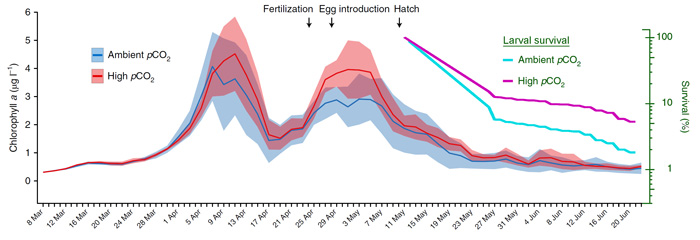| Tweet | Follow @co2science |
Paper Reviewed
Sswat, M., Stiasny, M.H., Taucher, J., Algueró-Muñiz, M., Bach, L.T., Jutfelt, F., Riebesell, U. and Clemmesen, C. 2018. Food web changes under ocean acidification promote herring larvae survival. Nature Ecology & Evolution 2: 836-840.
Writing to introduce the rationale for their study, Sswat et al. (2018) say that "to date, ocean-acidification studies with fish larvae have focused on the direct physiological impacts of elevated CO2, but largely ignored the potential effects of ocean acidification on food web interactions." Thus, they set out to help rectify this oversight in the scientific literature.
Their work was accomplished by conducting a mesocosm CO2 enrichment experiment in a small fjord located off the west coast of Sweden, where they subjected endemic plankton communities to normal (380 µatm) or CO2-enriched (760 µatm) pCO2 seawater for a period of 113 days. Approximately half-way through the experiment they introduced Atlantic herring (Clupea harengus) eggs into the mesocosms, whereupon they studied their individual responses to elevated pCO2 seawater conditions, as well as their interactions with other primary and secondary producers in the food web. The results are summarized in the figure below.
According to Sswat et al., there was a CO2-induced stimulation of primary production, evidenced by the mean chlorophyll a concentrations depicted in the pCO2 treatments below. In addition, herring larvae survival was 19% higher under elevated, as opposed to ambient pCO2 conditions, revealing that "significantly more larvae has survived in the elevated CO2 treatment (3.2 ± 1.5%) compared with the ambient CO2 treatment (1.2 ± 1.0%)" (P < 0.05).
With respect to why herring larvae survival was enhanced, Sswat et al. write that a "CO2-induced stimulation of primary and, consequently, secondary production appears to have improved the food supply for herring larvae during this early life stage." Thus, there was "a positive, bottom-up effect of elevated CO2, from primary to secondary producers and from secondary producers to secondary consumers, [i.e., the herring larvae]."
In commenting on these favorable findings, Sswat et al. conclude that ocean acidification "has the potential to improve the food supply higher up the food web," adding that they also "emphasize the need to assess the food web effects of ocean acidification on fish larvae before we can predict even the sign of change in fish recruitment in a high-CO2 ocean." In other words, we cannot trust future fish population projections based on ocean acidification studies that neglect to incorporate the bottom-up effects of CO2 on primary and secondary producers within the food web. And since only a very small percentage of ocean acidification studies have investigated these interactions, we have a long way to go before the true impacts of this phenomenon are understood.

Figure 1. Mean chlorophyll a concentration (blue and red colors depict ambient and high CO2 levels, respectively) and herring larvae survival (turquoise and violet colors for ambient and elevated CO2 levels, respectively) over time. The shaded areas depict the standard deviations around the means. Adapted from Sswat et al. (2018).




